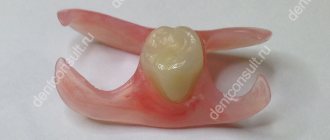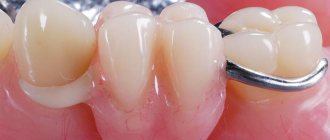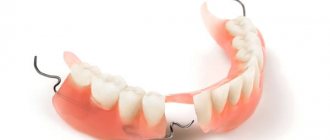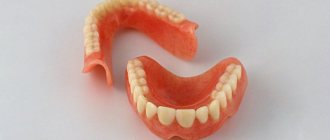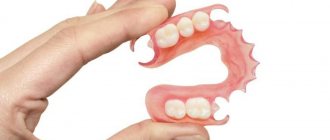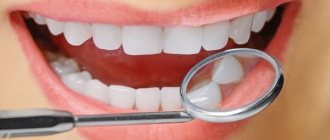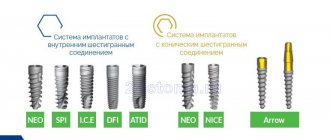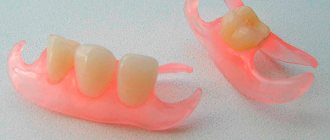Immediate dentures are used to temporarily replace permanent teeth during treatment. They are also called “butterflies”. They are installed for a certain period of time to give the smile an aesthetic appearance or for the purpose of getting used to a permanent prosthesis in case of prolonged absence of teeth. Their production does not take a long time. The service life is no more than 3 months.
The new generation design is designed to fix individual molars in cases where there are no teeth nearby. An immediate denture is a type of removable prosthetics.
In appearance it does not differ from a natural tooth. Clippers are located on the sides as fastenings, which fix the artificial molar. That is why they are called “butterfly”.
The false tooth is designed to prevent damage to soft tissue in the area of the removed molar. Most often, immediate is used in cases where a front tooth has been removed. In rare cases, the construction stops on other molars.
Butterfly denture – why is it called that?
The butterfly denture got its name due to the similarity of its soft base to the wings of a butterfly. Of course, such similarity can be called conditional, since the shape of the prosthesis depends on the number of artificial teeth and the length of the supporting part. With a large loss of teeth in one jaw, the design turns into a clasp prosthesis on attachments and no longer resembles a butterfly: this is why it is customary to call only mini-prostheses for replacing one or two teeth.
The butterfly prosthesis is fixed in the mouth using clasps - special hooks that extend from the base of the structure: they are usually made of soft transparent plastic and tightly grip the supporting teeth.
How to properly care for dentures
To ensure that the denture does not have to be changed after a month, it must be cleaned regularly. Since the orthopedic structure can be easily removed and put on, it can be cleaned with a regular toothbrush.
To avoid bad breath, hygiene procedures are carried out several times a day, preferably after each meal. But in cases where it is impossible to brush your teeth immediately after eating, it is recommended to use special mouth rinses.
The immediate product must be removed at night. Diet changes will also be required. The implant is not intended for chewing hard or sticky foods.
To prevent the prosthesis from falling out, doctors recommend using special pastes designed for fixing removable structures.
When is a removable butterfly denture suitable?
As already mentioned, a removable butterfly denture is installed when it is necessary to replace one or two teeth. Most often this occurs after the implantation procedure, when it is necessary to replace the empty space while the implant is healing. First of all, this concerns the frontal zone, where aesthetics are important (do not walk around with a gaping hole instead of a front incisor). A butterfly denture for the front tooth is considered one of the most common removable structures when performing implantation in the aesthetic zone, but one should not think that when restoring molars and premolars, a temporary butterfly denture is not needed at all. The fact is that the loss of even one tooth seriously affects the functioning of the entire dentofacial apparatus. Firstly, the chewing load is not distributed correctly, which can lead to problems with bite and gastrointestinal tract (due to poor chewing of food). Secondly, neighboring teeth begin to shift to fill the missing space, so in the absence of a replacement prosthesis, the entire dentition slowly shifts, which can subsequently seriously complicate treatment. A butterfly partial denture solves these problems.
The only thing that such a prosthesis will not save from is bone tissue atrophy, which begins to occur after tooth extraction, but this problem is solved after the implantation of a titanium implant.
Indications and contraindications
Most often, immediate dentures are installed to restore aesthetics during long-term treatment, which takes several months. The design allows the patient to speak and smile without embarrassment.
In addition, temporary implants are installed for:
- Protection of healthy molars. A denture allows you to avoid displacement of healthy teeth and maintain their location. After installing a fixed or removable structure, the dentition will retain its beauty.
- Restoring functionality. Most often, during treatment, the patient experiences not only moral discomfort, but also physical discomfort. This is due to the fact that missing teeth causes difficulty in chewing food. As a result, the stomach experiences great stress. To prevent this from happening, a temporary prosthesis is installed. It allows the patient to chew fully.
- Habituation. When teeth are missing for a long time, it is quite difficult to get used to it after installing a permanent structure. Immediate dentures allow you to solve this problem, and a person begins to feel new teeth even before the installation of removable or fixed structures.
Pregnancy or poor blood clotting are not a contraindication. The “butterfly” is not installed only if the patient has an individual intolerance to acrylic. This is what the implant is made from. There are no further contraindications for installation.
The technician must be as precise as possible when creating the implant, as the prosthesis may not fit into place. The process of making a prosthesis for one tooth consists of several stages:
- Even before removing damaged teeth, the doctor takes impressions.
- The dental technician makes an exact replica of the patient's mouth according to the impressions taken. The materials for its manufacture are plastic or nylon. The attachment of an artificial tooth is formed on the basis of neighboring teeth.
- The patient applies the prosthesis. In some cases, adjustments may be required.
Rules for caring for removable dentures made of plastic
The algorithm when a patient is missing two or three teeth is the same. But at the same time, the dentist must pay attention to the supporting teeth where the implant will be attached.
Only strong and healthy teeth can hold the structure. If the neighboring teeth are damaged or loose, the addiction will be much longer and more painful. In this case, the prosthesis is made of nylon.
Pros and cons of butterfly dentures
The quality of a butterfly prosthesis directly depends on its material and the professionalism of the specialists who will install this structure. In general, a temporary butterfly prosthesis has two key advantages, due to which this design has been widely used in dentistry for a long time.
- Replacement of the chewing function of the tooth. It is better not to subject a removable denture to heavy loads, but it copes quite well with chewing regular food.
- Not bad aesthetics. Modern designs (especially the nylon butterfly prosthesis) provide a very decent aesthetic result. When using transparent clasps, the butterfly prosthesis will not be visible on the gums.
However, it should be understood that a complete tooth replacement cannot be carried out using this type of prosthesis. The butterfly prosthesis also has a number of disadvantages that many patients have to put up with while wearing it. All the pros and cons of this type of prosthetics are outlined in the table below.
- No grinding of teeth.
To install a butterfly denture, you do not need to grind down adjacent teeth. - Easy care.
The structure must be washed with running water and cleaned with a brush, and placed in a special solution overnight. - Low cost.
We will tell you more about how much a butterfly prosthesis costs below.
- Difficulties with adaptation.
Immediately after installation of a butterfly prosthesis, problems with diction and discomfort when biting may occur. - Fragility.
This prosthesis breaks quite easily and does not have a long service life. - Allergic reaction.
When installing dentures made of acrylic and plastic, allergic reactions are possible.
Indications for installation of a prosthesis
The main purpose of the design is to restore one or two incisors followed by bridge prosthetics or before implantation. Contraindications may include:
- the incisors that will serve as a support for the structure have serious damage (carious lesions, erosion, damage to tooth enamel, etc.)
- the presence of inflammatory processes in the cavity;
- in cases where the jaw arch has a deformation or anomaly in development;
Installation of the structure is possible, but only after these problems have been treated.
Removable butterfly prosthesis – price in Moscow
The price of a butterfly denture, like all structures of this type, is not fixed. The cheapest samples cost an average of 3,000 – 5,000 rubles, but they are not always of high quality, which significantly affects the patient’s comfort. Budget prostheses are usually made of fairly hard plastic, which does not look very aesthetically pleasing and can also cause discomfort and even pain when worn. The price of a removable butterfly prosthesis made of nylon in Moscow dentistry will be more expensive (from 12,000 to 20,000 rubles for the most modern designs), however, from both a functional and aesthetic point of view, such systems are much more effective.
Installation of "butterflies"
Immediate dentures are temporary structures and their wearing time is short-lived. They are installed for a period of no more than 3 months. But in some cases, wearing a prosthesis may be necessary for a longer period of time.
In order to keep the structure in good condition, it is necessary to take care of it and follow all the doctor’s recommendations. This will increase the service life of the implants.
But in dentistry, the procedure for permanent prosthetics can take a longer time. In this case, the dentist prescribes regular replacement of the temporary structure. The production time depends on several factors and can range from several days to one month, as during the creation of the first prosthesis.
Design features
- Basis. As a rule, it is made of metal and has the appearance of an arc. The metal frame is durable, and it evenly presses on the jaw, providing the correct load.
- Artificial teeth. They are usually made from dental ceramics. This helps ensure the aesthetics of the prosthesis. The design with ceramic crowns is not visually noticeable in the dentition.
The weight may vary depending on the type and design features, but usually it does not exceed 8 grams. Thanks to this, the patient quickly gets used to the orthopedic design; it does not cause discomfort or the sensation of a foreign body in the mouth.
Since the prosthesis does not rest on the palate, there are no problems with chewing, and the risk of a gag reflex is minimal. In this regard, they are superior to traditional removable products.
Advantages of removable immediate dentures
Immediate dentures are the most popular tooth replacement option. They are light, compact, easy to use and maintain, comfortable and do not cause inconvenience when wearing.
Their popularity is explained by several important advantages:
- fast production and installation;
- absolutely non-traumatic prosthetic procedure – no pain or discomfort;
- there is no surgical intervention during installation - this reduces the risk of infection and inflammatory processes;
- do not require grinding of supporting teeth;
- no contraindications;
- the absence of metals in the design guarantees the absence of oxidative processes and foreign taste in the mouth;
- do not rub or scratch gums;
- strong fixation (however, there is no 100% guarantee that it will not fall out);
- natural appearance – suitable for installation in the smile area;
- simple and easy care.
Butterflies can be placed on patients of any age, even the elderly and children. They do not cause allergies or other unwanted reactions.
Cost of implant installation
Egor
I’m writing, maybe the information will be useful to someone. My teeth fell out early and I didn’t want to walk with a denture. But I always thought that I couldn’t afford the cost of implanting ALL teeth. I was smart enough to go to a consultation, and there they explained to me, a complete idiot, that if all my teeth are missing, then I don’t need to get 32 implants. Enough 4 at the top and 4 at the bottom. And prostheses are firmly attached to them. It is much cheaper and quite adequate in cost. This design for one jaw can be ordered from 120 thousand.
Alina
My employee installed an implant in a “budget” clinic for 25 thousand, when I was puzzled by finding a good deal, I found it for 18. They did everything perfectly, the service not only pleased, but really delighted. Once again I was convinced that everyone’s budget is different!
PROMOTION
Osstem dental implantation turnkey
18,000 rub.
Service life and care
Caring for temporary structures made of nylon and acrylic is no different from other removable structures. The butterfly prosthesis must be washed with water after breakfast, lunch and dinner. Additionally, you can use an irrigator.
Due to the softness of nylon products, you should be careful when eating solid food (to avoid breakage and chips). Brush twice a day (morning and evening) with a toothbrush and toothpaste.
It is recommended to use a special solution for storage (as for conventional removable structures). In this case, avoid exposure to direct sunlight. To do this, you should purchase a container with ventilation holes from the pharmacy.
The standard service life of the structure is 24-30 months. With careful and proper care, the period can be extended to 36 months.
What material is the best microdental prosthesis?
If we are talking about a tooth that falls into the smile line, then it is better to make a micro-prosthesis from Acry-free material. However, you must understand that the price for installing 1 economy-class implant along with a metal-ceramic crown will start from 40,000 rubles (which is only 2 times higher than the cost of such a prosthesis). If we are talking about a chewing tooth, or you need a prosthesis for a short period of time and you do not require high aesthetics from it, a regular acrylic prosthesis will be sufficient.
But what to do if you have a unilateral terminal defect of the dentition. Indeed, in this case, neither dentures made of any type of plastic, nor dentures made of nylon, will fit well in the oral cavity. Of course, the ideal option in this case would be implantation, but due to age or contraindications, it may be contraindicated. In this case, the best option would be a clasp microprosthesis with an attachment. We hope that our article was useful to you!
Sources:
1. Personal experience as a dentist, 2. “Orthopedic dentistry. Textbook" (Abolmasov N.G.), 3. "Removable dentures: textbook" (Mironova M.L.).
How are butterfly dentures made and installed?
Butterfly dentures are made quite quickly and simply, and this is one of the reasons why they have a very affordable price. We will describe the process of production and installation of butterfly prostheses step by step:
- Impressions are taken - from the tooth that will be removed, as well as from the supporting teeth, since in order for the butterfly to hold firmly in the mouth, the design of the prosthesis must take into account all the structural features of the supporting units;
- The finished cast is sent to the laboratory, where a butterfly prosthesis is made from it - made of acrylic or nylon. Clasps are placed on the prosthesis;
- After the butterfly is ready, the patient is invited to try on the prosthesis. If, after putting on and securing the prosthesis, a person feels discomfort, the butterfly is returned to the laboratory for correction to the required parameters.
If the fitting does not reveal any inaccuracies in the manufacture of the prosthesis, the doctor will install and secure the butterfly in the right place, and also explain to the patient how to care for the prosthesis.
USEFUL TO KNOW: If diagnostics reveals the presence of caries on the supporting teeth, a large amount of plaque, and tartar, then even before taking impressions, it will be necessary to carry out treatment of carious lesions, as well as sanitation of the oral cavity.
Why is installing an immediate prosthesis not a waste of money?
Many patients believe that installing temporary structures is absolutely useless for health, but a significant blow to the wallet. You can save up for a full-fledged implantation, and the presence or absence of a tooth will not significantly affect your quality of life. We hasten to assure you that this is not the case.
Here are just some of the consequences:
- impaired diction, unclear speech;
- displacement of the dentition;
- increased frequency of caries episodes and erasing of enamel due to improper load distribution;
- premature aging and development of facial asymmetry;
- Digestive problems due to poorly chewed food.
These problems, together with the general aesthetic unattractiveness of this defect, allow us to say with confidence that a temporary removable denture is not only a profitable investment, but also self-care. It is worth noting that the price of a prosthetic “butterfly” tooth is quite affordable, and eliminating the resulting consequences will take a lot of time, effort and require significant financial investments.
Nylon immediate dentures
Nylon dentures are soft, flexible, and elastic. They are very comfortable, do not require long adaptation, and within a few hours after installation you will forget about them and stop noticing them.
Nylon structures are as close as possible to natural fabrics and look just like real crowns and gums. For this reason, it is recommended to install nylon dentures in the smile area.
They do not rub the soft tissues of the oral cavity, are easy to put on, and are firmly fixed. When installing them, the risk of injury is eliminated, which guarantees the absence of inflammation and gum disease.
Nylon is a material that does not contain metals or monomers, and therefore does not provoke allergies. It is easy to clean and is not a favorable environment for the growth of germs and bacteria. Prostheses based on it are as hygienic as possible.
When chewing hard food, nylon structures can become deformed and require careful use. They are somewhat more expensive in price than their acrylic counterparts, but this is compensated many times over by their convenience and practicality.
MANUFACTURING PROCEDURE
In order to provide the patient with maximum comfort and convenience when wearing the prosthesis, the design is made as follows:
At the initial stage, an impression of the patient’s jaw is taken. If the tooth is to be removed, the procedure is applied immediately before the operation. If a tooth is missing for a long period of time, an impression of the cavity is taken.
Next, using these casts, the crown of the missing tooth and fastenings are made. The materials used for this purpose are plastic, nylon, and metal alloys.
After the microprosthesis is manufactured, an initial fitting is performed on the patient. If discomfort occurs, additional polishing of the product is performed.
Are there any alternatives?
Of course, modern dentistry can offer alternatives to butterfly dentures. Instead of this type of prosthesis, the following can be installed:
- Plate dentures, which are also fixed on the supporting teeth using special hooks;
- Clasp dentures. Their peculiarity is the presence not only of clasps, but also of a special arc. Clasps stay firmly in the oral cavity, but their price will be higher than the cost of a butterfly prosthesis.
What type of prosthesis should I choose for temporary or permanent removable prosthetics? Only an orthopedic dentist can answer this question after examination and diagnosis.
Mayfly butterfly one day old insect
On an early, warm June morning, my friend and I decided to swim in the Moscow River. It was not far from Kuntsevo, where a dense forest grows on the high, steep right bank of the river.
Quiet and windless. Not a soul around. And on the opposite bank something incomprehensible was happening. There were thousands of fluffs floating in the air.
June snowstorm? No. These are flocks of graceful mayfly butterflies with transparent mesh wings, like a dragonfly, and a thread-like tail. A mayfly butterfly has just fledged. She's lucky. What a day! The sky is clear.
Almost all mayfly butterflies (and there are 1,500 species of them) live for one day. True, there are species that exist for several days, several hours and even several minutes. But in general, mayflies live up to their name. Their larvae are more durable, they develop for two or three years. But these are larvae, it still “doesn’t count”...
Mayflies do not need food, although they do have a stomach and intestines. They do not need digestive organs; they are filled with air. This butterfly has no mouth and will never drink a single drop of nectar in its entire life. She probably doesn't have time for that. Hard to say. Once upon a time, in the very distant past, the ancestors of mayflies may have drank and ate something.
How will the mayfly butterfly live its only day?
One day in the life of butterflies is like a fairy tale. Gathering in large flocks in the first minutes of their birth, they set off on a “celebratory” flight. Rhythmically, sometimes rising up, sometimes falling down, mayflies circle above the river, performing dances in the air.
I saw this “ball”. Butterflies, as if caught by an unexpected gust of wind, fly like snowflakes, but do not fall to the ground. A moment - and the males began a whirlwind flight. But female butterflies burst into the thick of the “blizzard”, get close to the dancer, and the couples disappear into the distance.
The male dies first, and the mayfly soon flies to the water and, at the end of the only day of its life, lays up to 10 thousand eggs. Not all of her offspring will survive - most of them will be eaten by fish.
Larvae are born from the eggs. They either continue to develop in the water or burrow into the mud. Some build their burrows on the shore, others crawl under rocks, and still others live among plants. While the larva matures, it manages to shed its chitinous clothes twenty times, or even more. And only then comes the time of transformation - the time of birth of the mayfly.
From larvae living in calm waters, an adult insect is born in an unusual way. Gases accumulate in the space between the cover of the larva and the body of the future insect, as well as in its stomach and intestines. The larva inflates like a balloon and floats to the surface. This, it turns out, is when the digestive organs come in handy.
And here the skin is already “bursting at all the seams,” and the mayfly butterfly is born right there. She sits on her larval shell, like on a tiny boat, dries out and gains strength.
When will she take off?
This is what I didn’t know. One day I began to follow a floating “ship” with a passenger on top. It took no more than a minute to see a rare sight. Suddenly the skin on the back of the butterfly burst, at first it seemed to me that the mayfly had died for some reason... But in fact, the insect had its first and last molt after birth. Soon, after two or three attempts, a fully grown mayfly took off and immediately disappeared in a general stream of white living snowflakes.
One day - the entire life of a mayfly butterfly is lived. Her offspring were left without “supervision.” But be that as it may, from 10 thousand eggs many butterflies will be born. The species will flourish.
Not all animals can afford such “carelessness.” Not everyone has such an abundance of embryos. So you have to take care and protect your offspring.
Advantages and disadvantages
The design is attractive at an affordable price as a temporary measure and a permanent prosthesis if it is impossible to install a bridge or implant.
Positive aspects of a removable microprosthesis:
- Can be installed immediately after tooth extraction.
- Artificial crowns and base are matched to the color of the gums and enamel.
- There is no need to grind down healthy teeth.
- Plastic clasps do not damage the enamel of the supporting units.
- It doesn't take much time to adapt.
After prosthetics, temporary complications are possible: rubbing of the gums, increased salivation, impaired diction, discomfort in the supporting teeth. If a butterfly is placed on a tooth immediately after extraction, the prosthesis will have to be adjusted as the wounds heal. Nylon or plastic hooks are not noticeable, but reduce the reliability of the prosthesis and often break.
